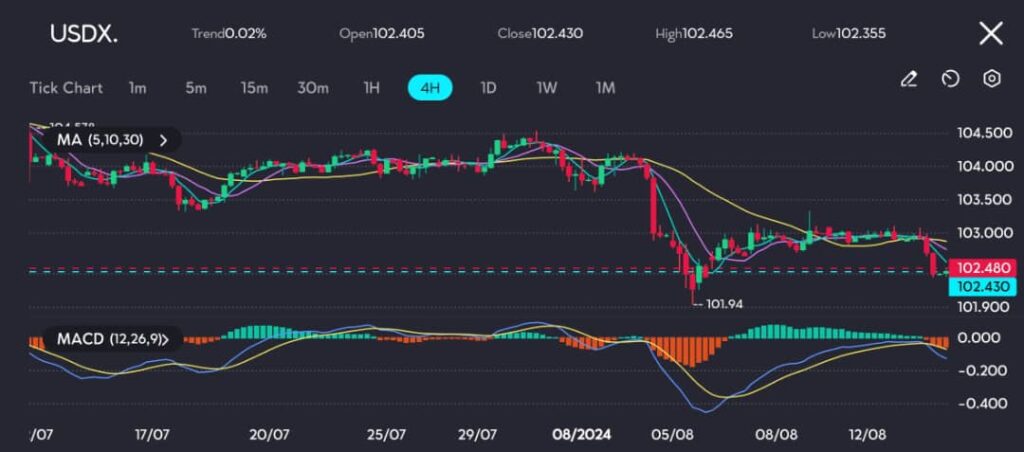Key points:
- The U.S. dollar index (DXY) remains under pressure after a soft U.S. producer price report, signaling potential Federal Reserve rate cuts.
- The New Zealand dollar falls 0.86% after the RBNZ cuts rates, contrary to some market expectations.
The U.S. dollar started Wednesday on shaky ground after tumbling overnight against major currencies, driven by a surprisingly benign reading on U.S. producer prices. This report has amplified expectations that the Federal Reserve might lean towards rate cuts later this year.

See: Dollar index trading at 102.430 as seen on the VT Markets app.
The US Dollar Index (USDX) on the 4-hour chart is displaying a bearish trend, with the price currently hovering around the 102.430 level. The index shows a downward movement from its recent high of 102.465, indicating selling pressure.
The Moving Averages (MAs) are sloping downward, signaling a continuation of the bearish momentum. The MACD histogram is negative, and the MACD lines are below the signal line, further confirming the bearish sentiment. Traders may be eyeing the support level near 101.94 for potential reversal or continuation opportunities.
Market eyes CPI after soft producer prices signal dollar weakness
This dovish sentiment stems from the latest U.S. producer price data, which showed minimal inflationary pressures. Market participants now keenly await the U.S. consumer price index (CPI) report, which could further solidify these expectations.
Meanwhile, risk-sensitive currencies found some support following the softer U.S. inflation data. The Australian dollar reached its highest point in more than three weeks, peaking at $0.66395 before stabilizing at $0.6630. Sterling also held near a two-week high, buoyed by a surprise drop in the UK’s jobless rate, trading at $1.2862.
NZD tumbles after RBNZ’s surprise rate cut amid economic concerns
In contrast, the New Zealand dollar (NZDUSD) faced a sharp decline, falling as much as 0.86% to $0.6040. The drop followed the Reserve Bank of New Zealand’s (RBNZ) decision to cut the key cash rate by a quarter point—a move that surprised about half of the economists and over two-thirds of traders who had not anticipated such action.
This marked a stark reversal from the central bank’s previous stance, which had hinted at the possibility of further rate hikes just three months ago. The RBNZ’s unexpected shift reflects the growing concerns over economic resilience, with the rate cut aimed at providing relief to households and businesses.
You might be interested: Australian dollar faces resistance while kiwi advances awaiting rate decision
Yen steady despite political uncertainty as dollar edges higher
Elsewhere, the Japanese yen showed little reaction to local political developments, with the dollar adding 0.24% to 146.52 yen (USDJPY). The yen continues to consolidate around the 147 level, with market participants largely unfazed by reports suggesting that Prime Minister Fumio Kishida may not seek re-election in his party’s upcoming leadership race.
As markets await the release of U.S. CPI data, cautious positioning is likely to dominate. Any surprise in the inflation numbers could lead to sharp moves across currency pairs, particularly if the data diverges from expectations.
Traders should be mindful of the potential volatility that lies ahead, particularly in light of recent central bank actions and the evolving economic landscape.
Start trading now — click here to create your live VT Markets account.







